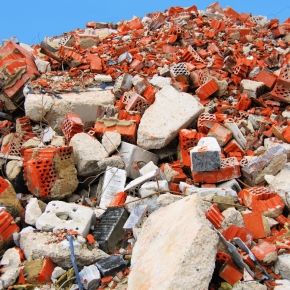How the built environment sector tackles its waste
Contents |
[edit] Introduction
Concerns about the environment and globally produced waste are rising. A widespread understanding that this isn’t sustainable has led to various sectors looking for ways to address their own waste issues.
As reported by a Wrap study, the built environment sector is the UK’s biggest consumer of natural resources. According to their study, the sector uses 400 million tonnes of material every year, which results in 100 million tonnes of waste being produced. To put this in context, this level of waste contributes over a third of the UK’s total yearly waste amount.
How can such a shocking amount of waste be produced and what remedies can the built environment action to reduce the level of waste?
[edit] Built environment sector waste
As reported by Resource’s Allan Sandilands, lack of media coverage is the main reason for the insufficient public response on the problem of the built environment sector’s waste. Where plastic pollution has been heavily documented in regard to its effects on wildlife, Sandilands notes no such coverage has occurred for the construction industry, which he refers to a the “silent sector”.
Sandilands believes that badly enforced compliance measures, discordant procurement stipulations, and the habit of shifting the responsibility from clients to contractor, are causing the built environment sector to fail in managing waste responsibly.
The built environment sector will only adjust its waste-based behaviour if it gains an understanding of how beneficial recycling and reutilised materials are. But Wrap highlights how the sector is missing out on more than just the benefit of reducing waste levels, showing how tackling construction site waste can help to:
- Save natural resources.
- Keep compliant with legislation.
- Reduce CO2 emissions as well as waste levels.
- Reduce costs of purchasing materials by reusing materials instead.
- Bring in money by collecting and recycling materials.
[edit] Things that can be done
So, what actions can be taken? The main way would be to establish a Site Waste Management Plan (SWMP). This plan helps sites to keep track of their waste, as well as outlining how waste material can be reused or recycled where possible.
Although this might sound like a big task, it will be beneficial for the project in the long term. Plus, you can speak to a waste management supplier, in regard to creating a Site Waste Management Plan; they will be able to advise you on the best ways to segregate your waste material, which skips you need, and how to safely dispose of any hazardous materials.
Another way to reduce its waste is for construction companies to keep track of their ordering process and to predict the quantities they might need by looking at previous projects in order to avoid unnecessary materials. Plus, a review of storage facilities can ensure the materials last as long as possible; is your storage site waterproof and secure?
Construction companies should also consider whether off cuts can be used as a substitute for raw materials. Alternatively, explore the option of selling or donating unused materials in the event that you cannot return them.
If reusing or repairing isn’t possible, companies could opt for recycling rather than disposing. If you have an outsourced waste management provider, they will be able to help advise on this. Recycling is obviously a good option for the environment, but it can also save you money on landfill tax.
[edit] Future waste innovation
It looks like the future is going to offer different pathways for the sector to tackle waste issues. For example, according to World Economic Forum there are potential new building materials that would help manage and reduce waste by making use of food excess. In fact, the source reports that some companies have already begun to tap into this resource; the use of mushrooms for creating bricks in a tower construction, building materials made out of corn cobs, wheat, and even banana plants. Pineapple as a leather substitute, fabrics from citrus peels — if these ideas catch on, the issue of construction waste could be combatted hand-in-hand with waste from other sectors.
Reducing waste is an important issue that all sectors, including the built environment need to address. It is the responsibility of the sector to do as much as possible to reduce, reuse, and recycle its materials wherever possible.
[edit] Sources
- http://www.wrap.org.uk/sites/files/wrap/Reducing%20your%20construction%20waste%20-%20a%20pocket%20guide%20for%20SME%20contractors.pdf
- https://www.reconomy.com/blog/how-can-good-design-minimise-waste-construction-industry
- https://www.weforum.org/agenda/2017/11/could-food-waste-be-used-as-a-construction-material-to-build-our-cities-of-the-future
- http://www.csrwire.com/blog/posts/1725-five-ways-companies-in-the-construction-industry-are-focusing-on-sustainability-in-2016
- https://theconversation.com/cleaning-up-the-construction-industry-31
This article was originally published on 6 February 2020 on the CIAT website.
--CIAT
[edit] Related articles on Designing Buildings Wiki
- Biodegradable
- BREEAM Construction waste management.
- BREEAM Operational waste.
- BRE SMARTwaste.
- CIAT.
- Circular economy.
- Code of construction practice.
- Construction skip.
- Construction waste.
- Definition of waste: Code of practice.
- Fly-tipping.
- Hazardous waste management plan.
- Landfill.
- Landfill tax.
- Materials Management Plan (MMP).
- Recyclable construction materials.
- Recycling.
- Site waste management plan.
- Site Waste Management Plans - A Necessary Burden.
- Waste management plan for England.
- Waste management process.
About the wiki
Anyone is welcome to use and contribute to the wiki in different ways.
[edit] Engaging with the wiki
You can:
- Contribute to existing articles
- Create articles
- Share articles through social media and other channels
- Contact the CIRCuIT project to let us know what you think and how we can improve
[edit] Add your own content
To contribute to or create an article, you can follow these steps:
- Register as a user
- Read through the editorial policy and guidance on writing and contributing to articles
- See the detailed help page on tips on writing wiki articles
- Try editing a test article
- If editing an article, select 'Edit this article' underneath the article title
- If creating a new article, select 'Create an article'. In the 'Select categories' area, expand the 'Industry context' list and tag 'Circular economy' to add your article to this wiki
[edit] Who is this wiki for?
The articles contain information on implementing circular economy approaches in construction that could be relevant to:
- Architects
- Construction contractors
- Designers
- Developers, owners, investors
- Engineers
- Landowners
- Manufacturers and supplier
- Universities and research
- Urban planners
[edit] About CIRCuIT
The Circular Economy wiki is supported by the Circular Construction in Regenerative Cities (CIRCuIT) project, which is funded by the European Union's Horizon 2020 research and innovation programme. CIRCuIT is a collaborative project involving 31 ambitious partners across the entire built environment chain in Copenhagen, Hamburg, Helsinki Region and Greater London. Through a series of demonstrations, case studies, events and dissemination activities, the project will showcase how circular construction practices can be scaled and replicated across Europe to enable sustainable building in cities and the transition to a circular economy on a wider scale.







